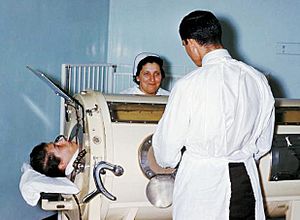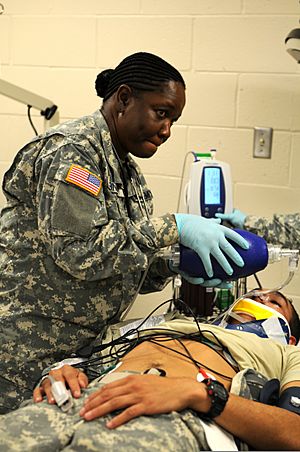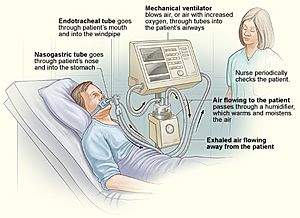Ventilator facts for kids
A ventilator is a special machine that helps people breathe. It moves air into and out of their lungs when they can't breathe well enough by themselves. Sometimes, ventilators are also used to give patients medicine that makes them sleep during an operation, called anesthesia.
Contents
How Ventilators Help You Breathe
All ventilators work by using pressure to move air. They gently push air into your lungs and then let it out. There are different kinds of ventilators that work in slightly different ways.
Manual Breathing Helpers
Some ventilators need a person to operate them by hand. These are called manual resuscitators. They are often used to help someone breathe for a short time.
A common type is a bag-valve mask (BVM). It has a mask that covers the patient's nose and mouth. A special bag holds air and is squeezed by hand. When a person squeezes the bag, air is pushed into the patient's lungs. When they let go, the patient breathes out, and the bag refills with fresh air. This is repeated to keep the person breathing.
Another type is an amnesia bag. This bag does not refill itself. It is filled with air or gas beforehand. A person can squeeze it, or the patient can breathe the air from it if they can breathe a little on their own.
Automatic Breathing Machines
Mechanical ventilators work by themselves. They are usually controlled by computers. These machines can get power from electricity or from compressed air, called pneumatics.
They can connect to a patient using an oxygen mask. Sometimes, a breathing tube is placed into the patient's nostrils, larynx, or trachea. Mechanical ventilators are used when someone needs help breathing for a longer time.
Positive Pressure Ventilators
Most modern ventilators are positive pressure ventilators. They work by blowing air into the patient's lungs. This air can come from the outside or from an oxygen tank.
The air is pushed through a special container called a pneumatic reservoir. It can also be pushed by a spinning fan called a turbine. This forces the air through a mask or tube and into the patient's lungs. After the air is pushed in, the patient breathes out through a special one-way valve.
Negative Pressure Ventilators

Negative pressure ventilators are also known as "iron lungs." These machines are large chambers that go around a patient's chest. They work by lowering the air pressure inside the chamber around the chest.
When the pressure inside is lower than outside, the patient breathes in. Then, the pressure inside the chamber increases, which helps the patient breathe out. This happens over and over again. Today, negative pressure ventilators are rarely used. Positive pressure ventilators have taken their place.
Images for kids
See also
 In Spanish: Respirador artificial para niños
In Spanish: Respirador artificial para niños




